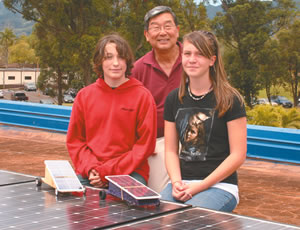Wheeler Solar Project Electrifies Students About Science

By .(JavaScript must be enabled to view this email address)
E-mail this story | Print this page | Comments (0) | Archive | RSS | Share
 Del.icio.us
Del.icio.us
|
Wheeler Middle School has a bright future in store, and with its recently acquired photovoltaic panels mounted to the rooftop, this alternate source of energy has led to smaller electric bills and greater student interest in solar power.
“Thanks to this system, the kids now have a greater understanding of how alternative energy works and how it can be made into a reality,” said John Lee, Wheeler’s industrial arts/shop teacher. “Solar energy is so popular now with the rising costs of fuel that it’s natural for us to want to teach our students about alternative energy sources and how they work.”
Lee’s shop class is offered as an elective course, and anyone in grades 6 -8 is welcome to sign up. One facet of the class focuses on creating solar-powered cars with mini PV panels mounted to them.
“In the past, when the kids have gotten to go up on the roof and see the panels at work, their initial reactions have been ‘Wow! Our cars aren’t even a fraction of that size!’ and they start to imagine what they could do with more,” Lee explained.
The panels were added through involvement with the Sun Power for Schools program, a 1996 partnership between HECO and the state Department of Transportation. Utilities customers often volunteer to help support the program in order to further the use of solar energy and help teach students about renewable energy.
“The DOE plays an important part in selecting the public schools that receive systems, and together with our staff make sure that the site is a good one. Then we all make it happen,” said Janet A. Crawford, communications consultant and spokesperson for HECO.
The program extends to schools that are customers of HECO and its subsidiaries. The total solar power provided amounts to 44 kilowatts for all the participating schools combined.
“The Big Island also just had the dedication of a system this summer at Konawaena Middle School,” Crawford said. “They actually have the largest single solar electric system installed there at 3.96 kilowatts.”
Most installations on Oahu only receive 2 kilowatts. Maui county and others usually receive about 1 kilowatt per school. But the systems don’t cover all of the schools’ needs. The amount of sunlight that hits the panels directly affects the amount and quality of power they receive.“The system on the Big Island provides roughly 300 kilowatt hours a month, for instance, so that’s nowhere near what the school needs, but every little bit helps,” she said.
Some schools use their systems solely for lighting and security needs.“Not all of the installations produce electricity for indoor use,” Crawford said. “How they use the energy is all up to them; we just help make it available.” The figures for solar output are posted at the end of each month at http://www.HECO.com.
E-mail this story | Print this page | Comments (0) | Archive | RSS
Most Recent Comment(s):













